Rose BR5 MKII Review – Chi-fi In Full Bloom
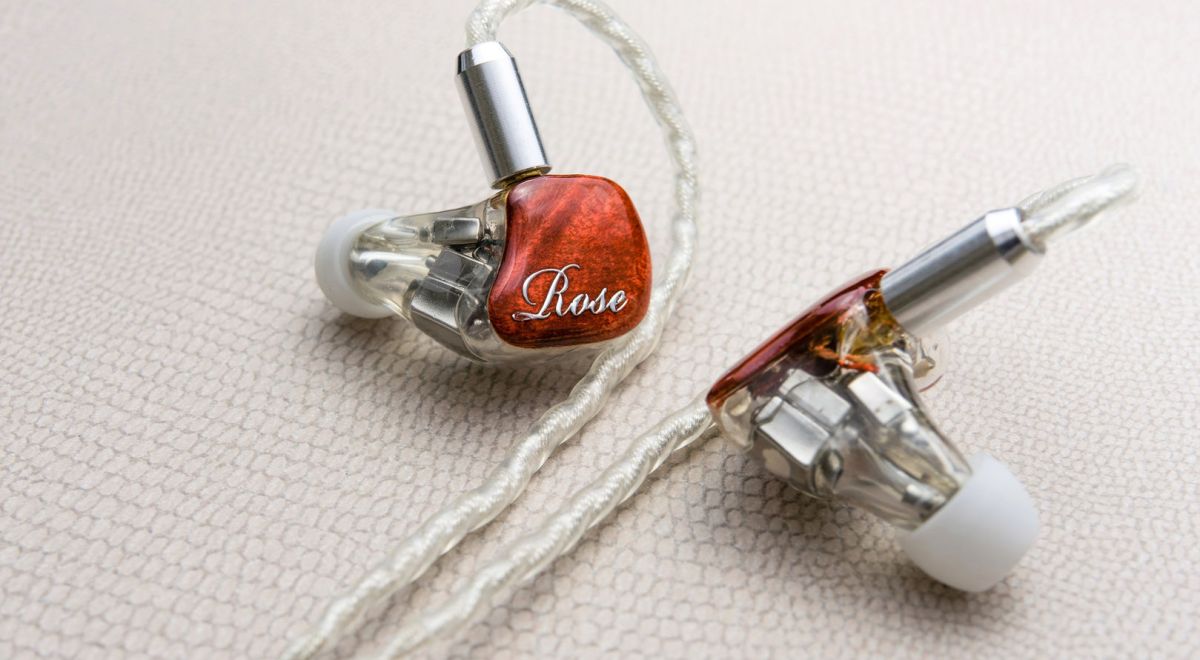
Introduction –
Until now, I’ve yet to review many truly premium Chi-fi earphone so the BR5 MKII really intrigued me. And that’s because these smaller brands usually leverage value as their greatest asset yet with a $300 USD asking price, the BR5 MKII is hardly for the faint of heart. It takes a lot of trust to leap into this price range and while value orientated Chi-fi IEMs like the KZ ZS5 can be rewarding impulse purchases, the BR5 is a heartier commitment.
Rose may not be a household name, but they’ve made waves on Head-fi as a Chinese audio manufacturer that’s a step above (and with pricing to match). Their dual driver earbud, the Mojito, cemented their name in the minds of many and pioneered their very neutral orientated house sound which pervades throughout their entire product lineup of varying price and form factor. The BR5 was one of their first attempts at an in-ear design and a pretty premium one at that. And with a 5-driver design utilizing components from Knowles and Zsound, the updated BR5 MKII promises strong sound quality comparable to significantly more expensive. Let’s see what Rose’s flagship armature in-ear is all about.
Disclaimer –
I would like to thank Chi Kong Hui from Penonaudio very much for his quick communication and for providing me with the Rose BR5 MKII for the purpose of review. All words are my own and there is no monetary incentive for a positive review. Despite receiving the earphones free of cost, I will attempt to be as objective as possible in my evaluation.
Accessories –

The BR5 MKII comes within a nice hard box that magnetically latches open. The latch has a metal plate engraved with the company slogan and interestingly, the rear showcases that the earphones have been “designed and made in China”. It’s definitely intriguing to see Rose brandish this like a selling point, reinforcing that we can’t generalize the quality of a product simply by its country of origin.

Inside is the BR5 MKII and some ear tips presented nicely within a foam cutout. Rose also includes a plastic case filled foams and a shirt clip in addition to a soft pouch and Westone-vault imitation hard case in the two boxes to the right. The hard case is exceptional, the vault case is easily one of my favourites and Rose’s derivative is just as compelling; perfectly sized, immensely protective and well presenting with a metal Rose plate at the top. Inside is a silver plated cable which is also of excellent quality.
Design –
The BR5 MKII pursues a custom-like design that will be immediately familiar to buyers accustomed to in-ears like the Ibasso IT03 and Kinera H3. However, to my ear, the Rose is substantially better shaped than both, achieving exceptional fit depth and seal that is among the best I’ve tested. In addition, Rose offer the earphone in countless configurations similar to customs with colour choices ranging from transparent to a vibrant blue and green in addition to varying faceplate textures to mix things up. I received the BR5 MKII with a red wood faceplate and transparent housings that I find to look pretty stunning.
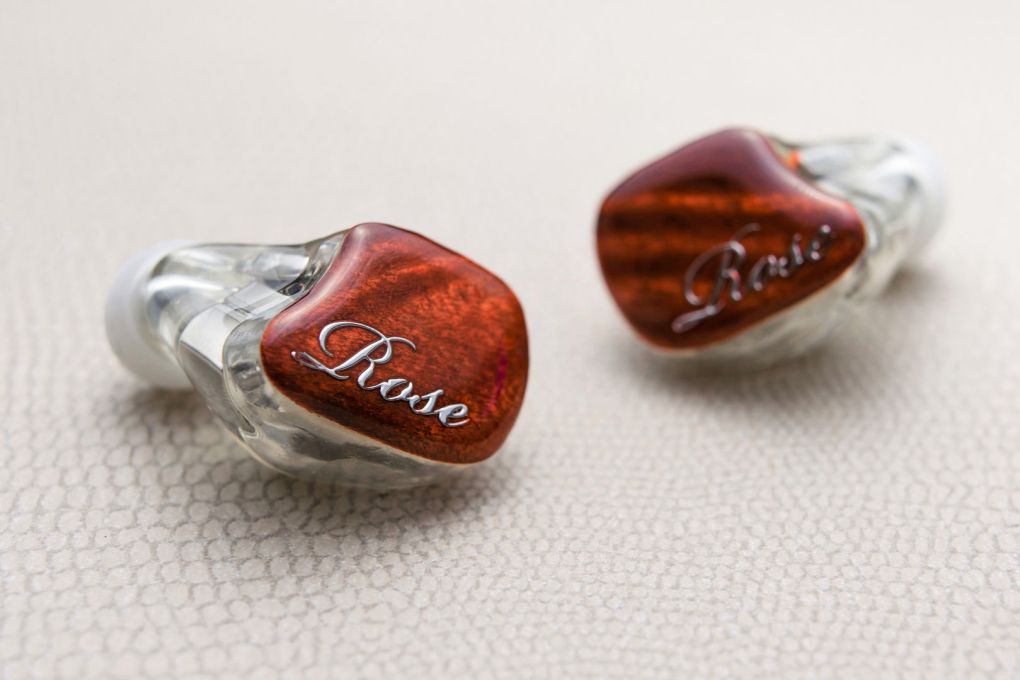
Build quality on the BR5 is good but not outstanding, chiefly because they are a plastic earphone lacking the solidity of the all metal cloaked Oriveti, Meeaudio and Dunu earphones. That being said, they do feel similar to models from Westone and Shure with no flex or visible joins in the plastic. Their transparent shells and perfectly joined wood faceplates with silver Rose text also grant them with a striking aesthetic that is only amplified by their braided silver cable. However, I do have some concerns with their construction, it would seem that the areas behind the driver assembly is hollow and the acrylic used by Rose isn’t perfectly transparent with a slight misting/haze to some areas but I didn’t find this to compromise the rigidity of the housings in any way. I doubt this is a limitation of Rose as an audio manufacturer since the Mini 2 has a perfect build; they likely did this to reduce the weight of the earphones and it does give them a more DIY look which has a certain charm. I would also intimate that the coloured options won’t be as affected.
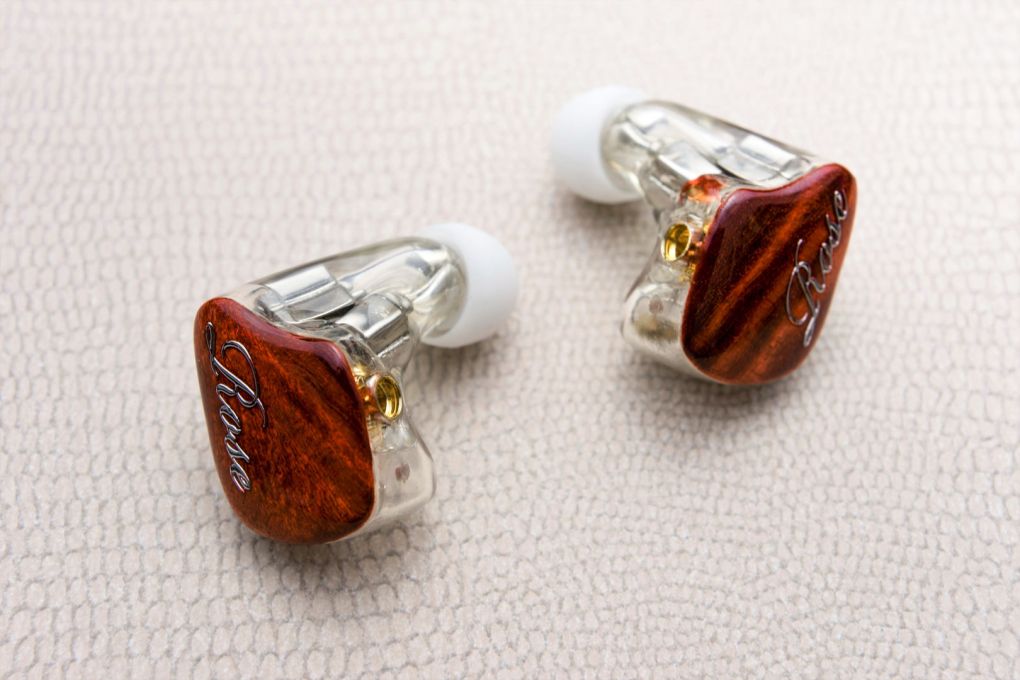
And despite their long dimensions, the BR5 MKII actually has a pretty low profile fit on account of their fit depth. I wasn’t able to comfortably sleep with them like the Oriveti’s, but wind noise was minimal when out and about and they look pretty sleak during wear. Otherwise, I have very few complaints with the BR5 MKII’s ergonomics, they are simply an impeccably formed earphone. What most stuck out to me was the BR5 MKII’s fit depth, they are as close to customs as universals get. And combined with their fully sealed design (there is a small vent behind the driver assembly but this doesn’t affect isolation at all), the earphones produce more isolation with silicone tips than most sealed in-ears with foams, perfect for travel and use in other louder environments.
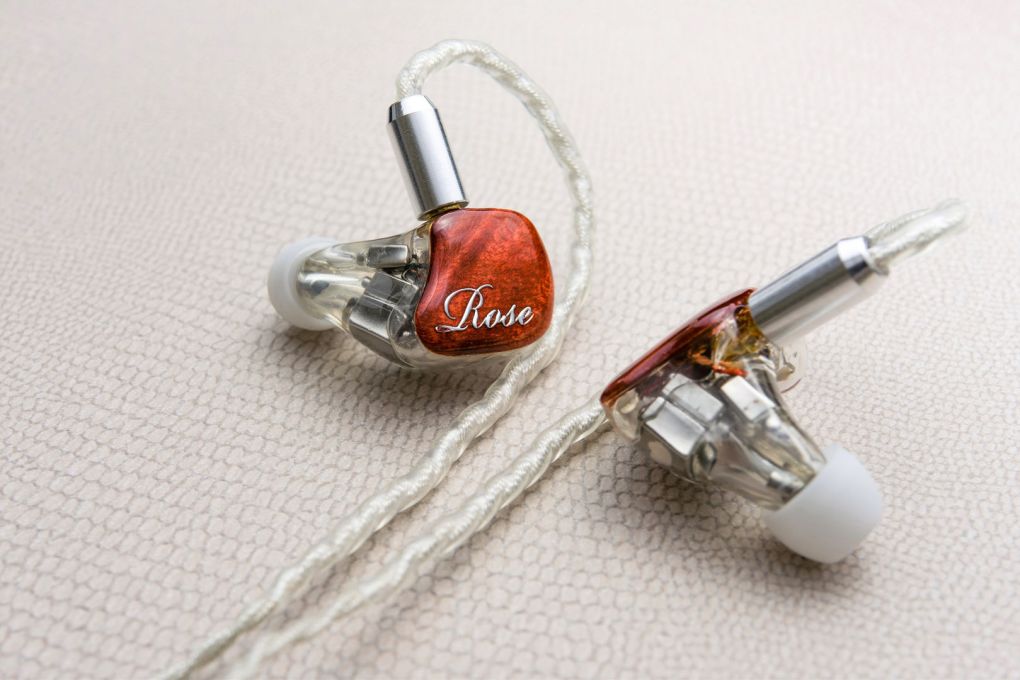
Stability is also faultless with an over-ear fit and that excellent fit depth augmenting some smart ergonomic forming on Rose’s behalf. However, this does come somewhat at the cost of comfort; while the BR5 MKII is small and smooth enough not to form any notable hotspots in my ears, they do produce quite a lot of pressure due to that deep fit and anything, no matter how perfectly shaped, will cause some level of discomfort at that depth. After a few days I acclimatised pretty well to the BR5’s however, listeners sensitive to pressure and bone conduction noise should probably consider a shallower fitting or vented earphone like the New Primacy. Otherwise, the BR5 MKII is more isolating and more stable than competitors, they just don’t disappear comfort wise.

The BR5 MKII utilizes a typical MMCX removable cable interface. The connectors are clicky and were completely reliable in my testing even with several different aftermarket cables. The stock cable is a very nice silver plated copper unit that is very supple with no notable memory or cable noise though it does have a slightly grippy texture. Otherwise, the cable looks fantastic with a loose braid, machined MMCX connectors and a straight 3.5mm plug laser etched with Rose branding. The Plug is also case friendly which is a bonus for smartphone users. In addition, the cables leave the earphones at the perfect angle which, in culmination with their well-shaped pre-moulded ear guides, creates a comfortable yet stable fit, something some other Chinese earphones like the Magaosi, Simgot and TFZ Exclusive earphones struggle with.
Sound –
The BR5 MKII is Rose’s flagship balanced armature earphone featuring a whopping 5 balanced armatures per earpiece. That’s easily one of the highest driver counts I’ve seen around this price if not the highest though, of course, raw driver count doesn’t always produce a more agreeable experience. And looking through the transparent housings, the user can see the 5 drivers inside, 2 mid drivers, 2 tweeters and 1 huge bass driver. Interestingly, my BR5 MKII had a 26ohm resistor on the bass driver, orders straight from Rose can be tailored to personal preference for a small fee. Rose promise that each of those components is of excellent quality; the BR5 MKII utilizes drivers from some really renowned in-ears, featuring the same midrange driver as the $1400 FitEar 334 and the same tweeter driver of the JH24 to name a few. So with 5 quality drivers, the rest of the BR5’s performance comes down to housing design, dampening and, to an extent, the included cable. I was honestly concerned about Rose’s ability to weave these varied components into a coherent package, let’s see how the BR5 MKII performs as a single unit.
Cable and Burn-in –
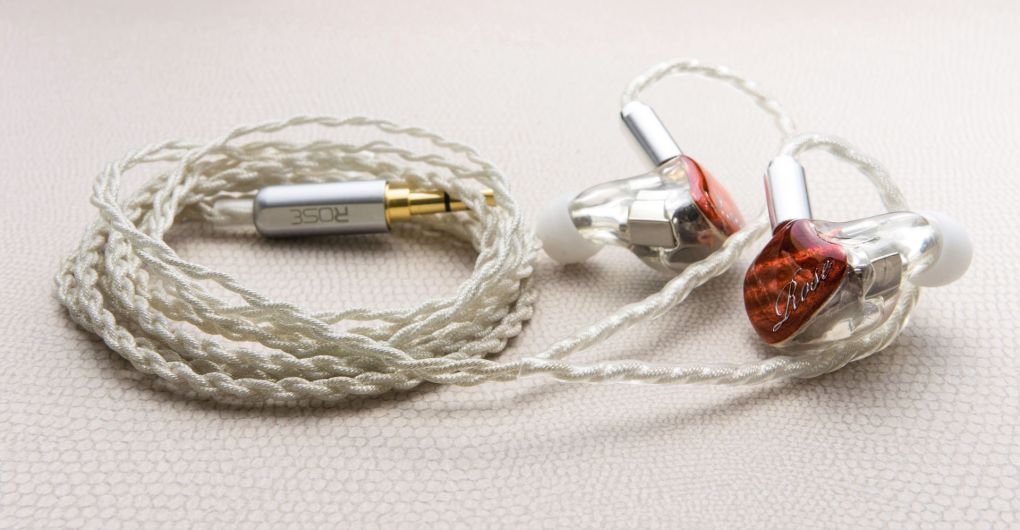
I put the BR5 MKII through around 150hrs of burn-in to little effect, perhaps bass presence slightly increased though this could also be due to adjustment of my own ears to the BR5’s leaner sound. The BR5 MKII is noticeably sensitive to cable swapping, my unit actually didn’t come with the stock cable, so I spent some time swapping cables around while Penon shipped me the official Rose cable. I found the BR5 MKII to sound best when fed from a quality silver plated cables; the Ourart Ti7 upgrade cable and Campfire Audio Litz cables both provided excellent resolution and low-end balance, the ALO cable also improved sub-bass extension to the extent of producing some real slam on certain tracks. The BR5 MKII also sounded nice from the Plussound Exo Series Copper though that cable didn’t produce the bass depth I was looking for even if the added midrange body and cleaner soundstage were very welcome. That being said, buyers shouldn’t feel that they are being limited by the stock cable which was perhaps even cleaner sounding than the SPC Ourart cable but the Rose did suffer when fed from a generic copper cable from Aliexpress (even though the listing specified SPC, I very much doubt it).
Drivability –
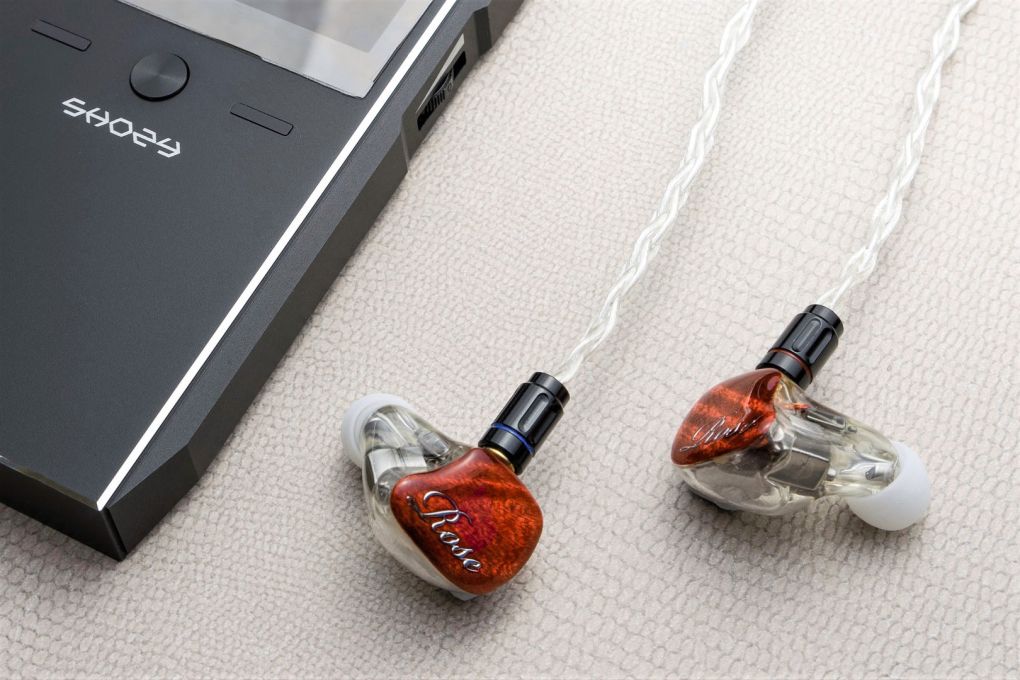
With a sensitivity of 115dB and a conservative 15ohm impedance, the BR5 MKII is very easy to drive, more efficient than the New Primacy and Cardas A8 but slightly less efficient than the Campfire Jupiter which has a similar impedance and sensitivity rating. They are also surprisingly consistent among sources, picking up far less hiss than the Jupiter and New Primacy despite their sensitivity. I can’t comment on why this is so, but they do sound noticeably different from devices with a higher output impedance. For instance, from my HTC 10, the BR5 MKII actually sounded slightly warmer with increased sub-bass extension when compared to my Mojo and X7 II. That being said, users will still want to feed the BR5 MKII from a nice source, due to their excellent resolution and detailing, the Rose earphones scale very well, gaining more bass texture, more vocal clarity and notably improved soundstage space when moving up from my HTC 10 and iPod Touch to my X7 II. As such, buyers wanting a bit more low-end might want to consider impedance adaptors combined with a high resolution dedicated source. Ultimately, the BR5 MKII is a very efficient earphone that avoids being too sensitive towards hiss, they sound very nice from a decent smartphone or MP3 player and only improve with higher quality dedicated sources.
Tonality –
Not only is the BR5 MKII a balanced in-ear, it’s also a very neutral one with Hifiman-like accuracy. They even make the Oriveti New Primacy sound bassy yet alone more dynamic offerings like the Cardas A8, achieving a similar level of balance to the considerably more price prohibitive Audiofly AF1120 with a little more high-end zing to boot. For my tastes, I would classify them as a brighter, sightly upper mid-forward earphone; bass takes more of a backseat and treble is clear but doesn’t steal the show. But don’t let that description scare you off, because it’s how the sound works as a whole rather than its individual components that grants it strength and the BR5 MKII is ultimately a very cohesive package characterised by a super clean midrange and generally fantastic resolution.
Soundstage, imaging and Separation –
The BR5 MKII is quite a spacious earphone, they possess notably strong depth and nice width that has plenty of reach but never sounds explicitly out of the head. Listening to Arcade Fire’s “Everything Now” and the BR5 MKII didn’t quite expand like the Cardas A8 but came surprisingly close to the vented New Primacy in width with noticeably more depth, surprising given that it’s the most mid-forward of the bunch. Imaging is a strong point of the BR5 MKII and accuracy is among the best earphones I’ve heard around the price. Their excellent resolution and speed made them just as precise as the Oriveti New Primacy if not slightly more so; placement is sharp and atmospheric effects are airy, directional cues are swift with minimal smearing. When listening to Jonathan Richman’s “Egyptian Reggae”, elements were well placed, the main and backing guitars were clearly separated and drums and bass avoided any muddling. The BR5 MKII still doesn’t match more expensive earphones like the 64Audio U3 and Campfire Jupiter in terms of space or imaging precision due to inferior resolution and micro-detailing, but they do hold a notable lead over most other $300 earphones I’ve heard, even armature sets like the SE535 and W30 don’t match the BR5’s speedy tones. Separation is very good but isn’t outstanding, the BR5 clearly delineates between instruments, even during complex passages, but they lack that sense of space and isolation around each element that higher priced in-ears achieve. Still, the soundstage prevents their mid-forward tones from becoming overbearing in a similar fashion to the RE-600S.
Bass –
Bass takes more of a backseat in the presentation with a very neutral tuning though they never come across as explicitly anaemic and quality is stunning. On that note, while I do prefer a more u-shaped tone in general, I can appreciate the balanced tones of the New Primacy and the mid-forward RE-600S. That being said, even the RE-600S has a some extra sub-bass while the hybrid driver New Primacy and dynamic Cardas A8 both far outstrip the BR5 in terms of low-end rumble and slam. The BR5 MKII has a noticeable lack of sub-bass, even deep bass is just passable with notable roll-off to the lowest of lows that saps rock and electronic of a lot of impact. But that’s not to say that the BR5 MKII has no bass at all, deep bass has some body and mid-bass has a nudge of emphasis that grants low notes with some extra fullness. In addition, bass is very linear above that roll-off and the BR5 maintains just enough low-end body and warmth to satisfy instruments such as drums and acoustic guitar. So, for the most part, bass is perfectly present, they have adequate extension and a nice sense of mid-bass fullness. Bass can sound nicely punchy they just never sound deep like more extended armature or dynamic/hybrid driver earphones; even when listening to songs such as Calvin Harris’ “Feels”, the BR5 MKII has no real slam or impact though bass still sounded full, clear and textured.
As one would expect, any bloat or muddiness is non-existent yet male vocals have nice body when called for and bass frequently surprises me with its punchiness. Texturing is also fabulous but they lack the extension to resolve much within the lowest registers. When listening to Earth, Wind & Fire’s “September”, the BR5 MKII provided a lightning fast bass response that was significantly tighter than the New Primacy and Cardas A8 but also one that was lacking the sub-bass snap of those rivals. Mid-bass remained punchy and was just as textured and dynamic as the New Primacy but clearer with improved definition. By contrast, the Cardas A8 provided the most textured response though its thicker response took a step back in outright bass resolution. The BR5 MKII’s bass response is probably its weakest aspect, not because of its conservative tuning, but due to its lack of extension and power. While bass is super clear and tight, the Rose still lacks the deep-bass presence to grant some genres with accurate timbre and body, limiting versatility. As an added note, I did try some equalisation to achieve a little extra low-end presence, but no matter what software adjustment I applied, the BR5 MKII seems incapable of reproducing the lowest frequencies.
Mids –
The midrange on the BR5 MKII easily steals the show in terms of both focus and quality. They carry a brighter tone with lifted upper mids and a more neutral lower midrange that is very coherent with the mid and upper bass response. Despite this, mids come across as clean and surprisingly natural on behalf of some fine tuning but users accustomed to darker earphones will definitely require some acclimatization. Starting with lower mids and the Rose impresses with a similar presentation to the Oriveti New Primacy; both are slightly clearer, full-bodied sounding earphones though the BR5 MKII is sweeter while the New Primacy is smoother. Both are also similarly strong in terms of resolution, the BR5 MKII layers slightly better while the New Primacy has a bit more definition to foreground elements though neither sound as fluid as the higher priced Campfire’s and 64Audio earphones. The Cardas A8 pursues an inherently different sound than both earphones, it has the most spacious midrange by far in addition to the most body. But while the BR5 and New Primacy can’t match its organic tone and exceptional sense of body, they are both clearer and more balanced. However, whilst lower mids will be a question of taste, female vocal aficionados will definitely want to look into the BR5 MKII; to my ears, the Rose has the best balance between presence, body and quality, their tuning is much more refined than their price would suggest. First and foremost, I get pretty touchy about clarity, because clarity often comes with a loss of body resulting in an unnatural sound. But the BR5 MKII is just right, they are clearer than the New Primacy and considerably clearer than the Cardas A8 while retaining a lot of body, granting vocals with a very realistic tone even with the thinner mastering of Asian albums.
Upper mids are the BR5’s trump card, they are quite forward and can dominate the mix on some tracks, especially electric guitar, but luckily, the quality of the BR5’s upper midrange is truly exquisite with superb layering and smoothness free of sibilance or grain; the BR5 flourishes with piano, strings, female vocals and acoustic guitar. Arianna’s “Komm Susser Todd” best illustrated the BR5 MKII’s strengths; vocals were super clear with excellent resolution and strings were very textured and appropriately positioned, avoiding over-forwardness. The New Primacy was almost as clear but lacked the depth of the BR5, sounding less natural. Despite not having the clearest tuning, the A8 actually provided a really nice rendition with immediate vocals that were smooth, layered and defined if lacking the resolution of the BR5’s. And onto detailing, the BR5 continues to impress with nice retrieval and a slightly more aggressive presentation though the New Primacy has a more refined presentation overall. The New Primacy also retrieves slightly more information within their upper midrange but the transition into their treble is overly smooth whereas the BR5 has a more aggressive lower treble that makes them the immediately more nuanced earphone but also one that reveals more faults in the source material. As such, the BR5 MKII has a lot of bite to its midrange where the New Primacy and A8 tend to smooth these regions off in favour of more musicality and long-term listenability. If you’re looking for a darker, more organic earphone, the A8 is a fantastic choice whereas the BR5 MKII is more suited towards vocals and critical listening but comes across as slightly too forward in extended listening. I still maintain my love for the New Primacy which lies roughly in-between; it isn’t as nuanced as the BR5 nor as clear and revealing but does find the best compromise between detail and fatigue (or lack thereof).
Highs –
But really it’s within the upper registers that the BR5 MKII will start winning fans, rewarding listeners with a very nice treble response that is also quite refined. Starting with tuning, lower treble is on the more aggressive side while middle and upper treble are smoother and less immediately crisp. This is where the BR5 makes the greatest departure from the Oriveti New Primacy which carries a more polite treble response that clearly lacks the sparkle, detail and air of the BR5 MKII. Extension is very good, not Campfire Jupiter good, but better than the Oriveti and RE600S with some nice texturing and body to high-hats. In addition, they are probably the most detailed earphone I’ve heard around this price, besting the Westone W30 and New Primacy in terms of both detail retrieval and presentation; guitar strums and cymbals, in particular, had great nuance and body. But despite landing more on the resolving end of the spectrum, the BR5 still clearly lacks the nuance of more expensive in-ears, the Campfire Audio Nova and Dunu DK-3001 for instance, are both more resolving than Rose’s earphone despite being less aggressive; they have notably more body and resolution to higher elements. However, it’s the smoother response of the Rose that lends it better towards longer listening sessions, while its forward midrange may tire, treble never builds pressure like more middle treble focussed earphones.
And to expand more on the quality aspect, treble resolution and clarity are both excellent as is texture. Cymbals tend to sound slightly tizzy but are otherwise very raw and lifelike. They still don’t detail as well as the 64Audio U3 and Dunu DK-3001 but on many tracks they get scarily close. Nirvana’s “Lithium” provided apt demonstration of the BR5 MKII’s performance, the cymbals in the opening were very well textured if not quite as extended and airy as the much more expensive U3 or as textured as the Dunu. Eric Claptons “Old Love” was similarly flattered with more attack to each guitar strum than the New Primacy combined with increased micro-detail retrieval to higher elements. If I have a main complaint with the treble response of the BR5 MKII, it’s that treble isn’t perfectly linear so resolution of really high detail isn’t fantastic and some texturing is lost to more refined earphones, most notable when listening to string instruments. Otherwise, the BR5 MKII is a very airy, mostly clean and incredibly detailed earphone that manages to keep up with more expensive models in many scenarios. They also aren’t a particularly fatiguing or treble forward earphone nor is any sibilance immediately present, treble is exquisite.
Comparisons –
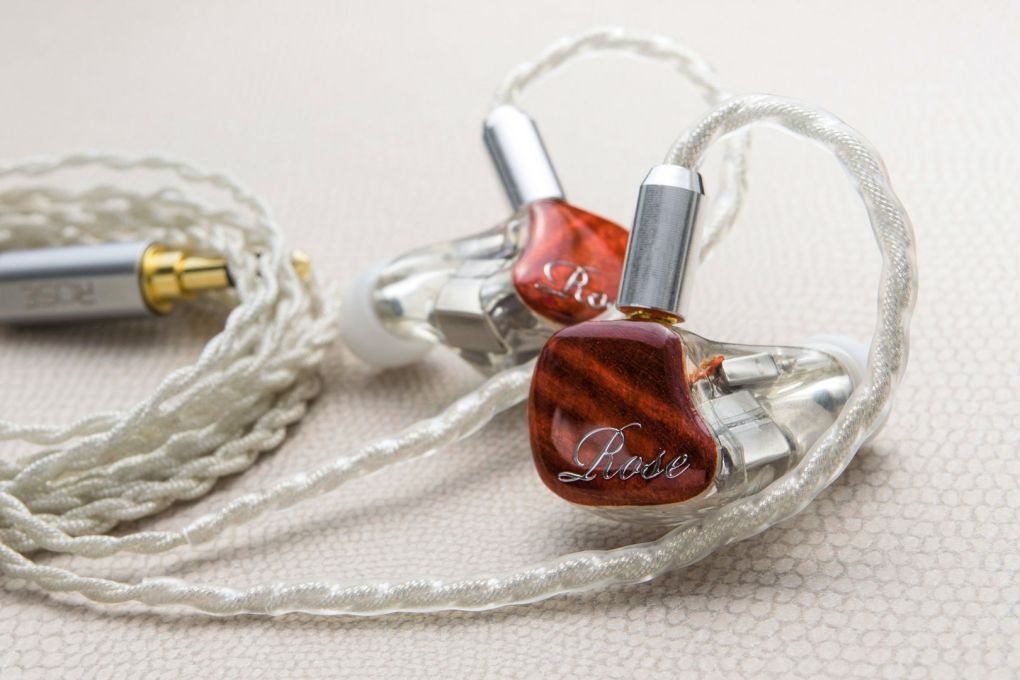
Kinera H3 ($99): Starting with design, both earphones are similarly shaped but the BR5 MKII sits considerably deeper in the ear and protrudes less as a result. The BR5 MKII, being fully sealed, isolates considerably better making it a better choice if you plan on buying an earphone for travel. While the Kinera is a fabulous earphone for the price, the BR5 MKII clearly has it beat on detailing, coherence and balance with the H3 sounding immediately more v-shaped. The BR5 MKII also has a nicer soundstage, especially with regards to imaging and separation.
What the H3 does possess is a much fuller, more extended bass response that still retains a lot of texture and definition if not quite the same resolution as the BR5 MKII. I can definitely see some people preferring the way they handle lower frequencies the BR5. Mids are much clearer on the BR5 though with less body. The BR5 doesn’t necessarily sound less natural but layering and vocal clarity is improved, especially within the upper midrange. Treble is also improved on the BR5 MKII, while they aren’t as aggressive as the H3, they are more even and more refined which benefits texturing and micro detail retrieval.
Westone W30 ($399): While I do generally like the way the Westone’s are designed, their thin plastic faceplates make them feel a little cheaper than the unibody Rose. Both fit excellently, again, the Rose has a deeper fit though the Westone isolates almost as much due to its long nozzle and ear-filling housing. The Westone is lower profile but its tubby housings aren’t great for sleeping, putting some pressure over the tragus. The Westone has a notably fuller mid-bass response and neutral deep-bass leading into a similar lack of sub-bass. Despite this, the Westone’s retain a lot of balance throughout as mid and upper bass are well-integrated with their slightly forward lower midrange.
The Rose on the other hand, is similarly integrated between bass and lower mids though both hold notably less emphasis in the overall sound, favouring the higher frequencies instead. As a result, the Rose is perceptibly faster and more defined within their bass response and lacks the tubbiness that occasionally affects the W30. Upper mids are inverted, the W30 carries a slightly darker tone, the BR5 MKII a brighter one. Both are really excellent performers though I would have to give the quality advantage to the BR5 MKII. If you are particularly sensitive to upper mids and listen to more rock, metal and electronic, the W30’s darker, bassier and more extended response definitely gives it the upper hand. However, for classical, jazz, modern pop and acoustic, the BR5 MKII holds an advantage with its superior soundstage space and improved midrange resolution.
Dunu DK-3001 ($499): The Dunu is actually a smaller earphone despite housing a mammoth 13mm dynamic bass driver and 3 balanced armatures. It has similar stability to the Rose but fit depth is considerably shallower and comfort isn’t quite as flawless due to the Dunu’s angular housings. Isolation is much better on the Rose, as far as ergonomics are concerned it would definitely be my pick for long term listening. The DK-3001 immediately has a much more dynamic, engaging response with that delicious sub-bass fullness driving their bass response with a general sense of weight to their low-frequency response. The BR5 MKII lacks the slam of the Dunu but above that, bass is faster and clearer if considerably more recessed within the mix.
Mids are much more upfront on the Rose though I still feel it is the more balanced earphone, by comparison, the Dk-3001 pursues more of a u-shaped tonality. The Dunu is similarly very clear, they aren’t quite as clean and upper mids aren’t as smooth as the BR5 MKII but layering better and detailing is improved. Lower treble is more aggressive on the BR5 MKII with clearer details and more bite in general. However, above that, the Dunu resolves more information whereas the BR5 MKII smooths off a bit more, which isn’t a bad thing, it takes the edge off what might otherwise become a tiring high-end response. Finally, the Dunu has a noticeably larger soundstage with better separation and similarly strong imaging.
64Audio U3 ($499): The U3 similarly employs an acrylic shell though the Rose feels a little more hollow but there is some charm in its DIYish nature. That being said, the Rose is easily the more eye-catching design. The U3 is another incredibly stable earphone with a very long nozzle that almost achieves the same fit depth as the BR5 MKII. However, the U3 is semi-vented due to those APEX modules and isolation does take a hit as a result, even when using Comply Foams. However, for exercise, the U3 is definitely my go-to, not only do the APEX modules improve sound staging and clarity, they also eradicate bone conduction noise when running/walking while the Rose is almost unbearable due to their super deep fit. Sonically, the U3 is actually tuned quite similarly, both have a very clear, slightly brighter midrange though the Rose doesn’t separate and layer like the U3 nor is it as spacious.
The U3 also has a slight bump in resolution over the Rose, though perhaps not to the extent one would expect, in addition to extra balance to upper mids, avoiding the over-forwardness that the BR5 is susceptible to. Treble extends more on the U3 with similar air and clarity though detailing is immediately superior as is treble separation on busier tracks. I really love the way the 64Audio earphones handle bass and the U3 is no exception, they have a sub-bass tilt with really nice extension and some impact if not quite as much as the Jupiter. The strongest asset of the U3 is their ultra-defined bass texturing which matches the Rose but with added nuance, body and extension. The U3 is a fabulously done “clear” sounding earphone though it also almost twice the price. The Rose gets incredibly close in terms of upper midrange and lower treble performance, but is the weaker earphones elsewhere and lacks the balance and linearity of the U3 overall.
Campfire Jupiter ($800): The Jupiter is easily among the best-constructed earphones I’ve handled with their all-metal build and exquisite silver plated litz cable. The Jupiter is more comfortable than the Rose due to its superior shaping and stability is similarly solid. Isolation is comparable to the Rose, both are some of the most isolating earphones I’ve come across. The Jupiter, being a much more expensive earphone, does hold numerous advantages over the Rose despite being at a disadvantage in sheer driver count (4 vs 5). Most noticeable is the Jupiter’s considerably improved resolution and separation which bring a sense of effortless refinement to every note over the BR5 MKII. The Jupiter extends considerably further into the lower frequencies with some genuinely satisfying sub-bass slam and rumble. Mid-bass is slightly fuller than neutral on the Jupiter as opposed to neutral on the Rose. As such, the Jupiter, despite being a very balanced earphone, comes across as immediately fuller and more dynamic, they have an excellent bass response that can compete with some dynamic driver earphones.
Mids also take a different approach, again, the Jupiter possesses more resolution and quite a bit more midrange body which greatly aids layering and general imaging, transience and immediacy, however, the Rose has a lot more midrange clarity without coming off as unnatural, no small feat. The BR5 MKII has a notably more forward midrange, especially upper mids though lower mids also draw more attention due to their more sedate bass response while the Jupiter is more even throughout. Treble is interesting, the Rose presents similarly to the Jupiter with a very resolving response however, the Jupiter takes this a few steps further in terms of refinement; the Jupiter just sounds cleaner and more effortless with greater timbre to details and more realistic texturing to cymbals and strings. The BR5 MKII is definitely a very good $300 earphone, but though it may utilize some components from earphones costing closer to the Jupiter, they still fail to really match that earphone on outright quality.
Verdict –
There is a certain beauty to the BR5 MKII’s sound; sure it’s no Jupiter, but Rose provides listeners with the same kind of balance found around these price ranges for much, much less. In addition, the quality of the BR5 MKII’s sound is really exquisite, especially their upper midrange and treble response. Their bass response is excellent in many ways, it is one of the clearest, fastest bass responses I’ve heard around this price and even above it, but the BR5’s limited extension and occasional midrange dominance simply don’t do its excellent quality justice; bass and treble details tend to get overwhelmed by the midrange which really limits genre versatility. So overall, I do think the BR5 MKII provides that same sense of value provided by some of the more outstanding budget orientated Chi-fI earphones, even at their arguably premium $300 asking price.
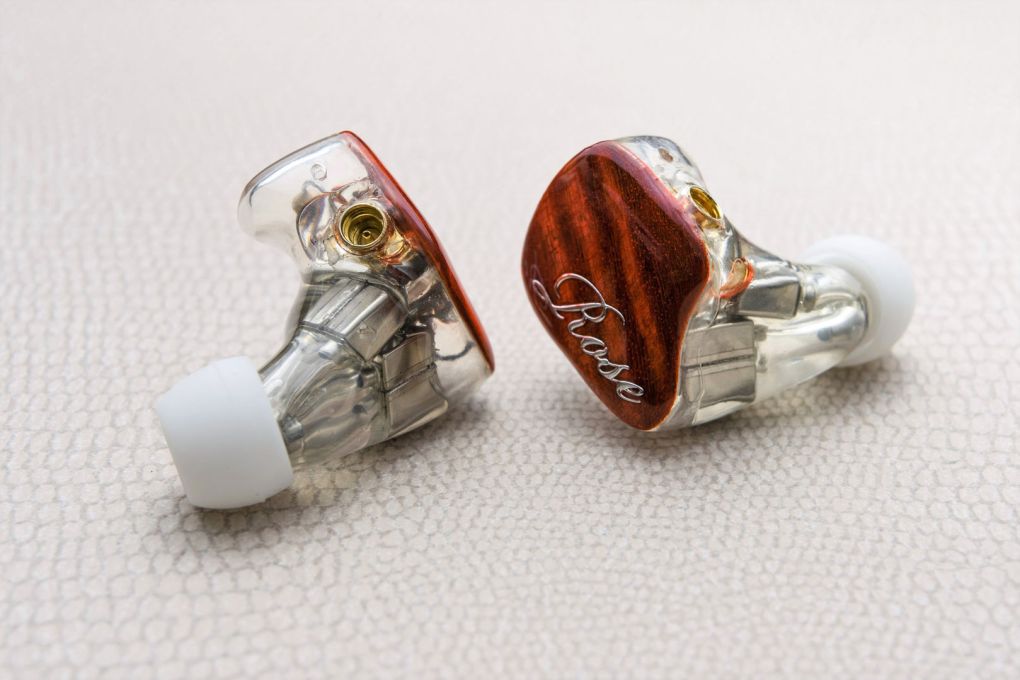
It’s clear from my comparisons that the BR5 MKII still doesn’t compete directly with pricier earphones despite having a high driver count and some lofty marketing claims, once again demonstrating the importance of refinement. While the components are certainly there, the BR5 MKII is clearly lacking the balance and evenness of more expensive offerings and their lack of sub-bass extension and general low-end fullness does bother. Of course, after a few days, a lot of listeners can acclimatize to the BR5’s mid-forward tones, but they never quite come across as balanced as the AF1120 eventually did. So if you don’t mind some issues with the build and their super deep fit, the BR5 MKII is possibly the best midrange focussed in-ear you can get for the money. However, if you want a deep bass response, musicality and long-term listenability without fatigue, the smoother, better constructed and more comfortable competitors from Oriveti and Cardas are just as compelling in many aspects.
Verdict – 8.75/10, The BR5 MKII has an intriguing design and an excellent fit. Furthermore, they sport class leading detailing and an absolutely heavenly midrange that will please even the most discerning of vocal lovers. However, as much as I love the BR5 MKII’s high-end, I do have some qualms with their slightly misty, hollow housings and their lack of bass extension and body will limit recommendation.
The BR5 MKII is available from Penonaudio (International) for $305 USD, please see my affiliate link for the most updated pricing, availability and configurations.


Hey there, thanks for the great review! Do you think there are currently any Chi-fi IEM’s that can even begin to compete with the likes of the jupiter/other TOTL IEM’s? If not, which do you think are the closest to it?
LikeLike